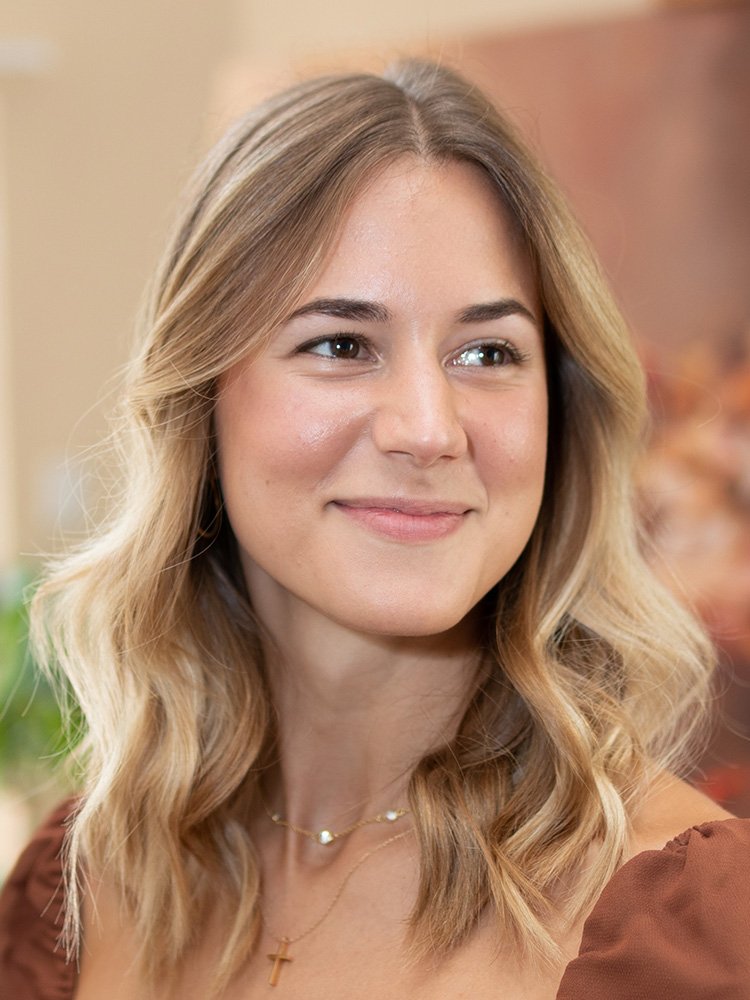Meet St. Louis-based Artists George & Polly Capps
George and Polly Capps are St. Louis, MO-based visual artists specializing in oil painting. Visit their website at Goretti Fine Art.
CATHOLIC ARTIST CONNECTION: Where are you from originally, and what brought you to St. Louis?
GEORGE AND POLLY CAPPS: We are originally from St. Louis. After high school, we both attended college at Stanford University in Palo Alto. George stayed in California for graduate studies and worked in the San Francisco Bay Area for a couple of years before returning to Missouri about ten years ago to be closer to family. Polly also returned to the Midwest more recently after earning her degree in fine art.
How do understand your vocations as Catholic artists?
We are Catholic artists, both in the sense of being professional artists who are Catholic and in the sense of producing artwork in the service of the Church. In both senses, we see our mission being (1) to glorify God by exercising our creative imagination and (2) to communicate Truth through the medium of beauty.
Where have you found support in the Church for your vocations as artists?
There is long history of thoughtful writing (by saints, theologians, and even popes) on the vocation of artists and on the role of visual art in the life of the Church. We find inspiration in texts such as John Damascene's Apologia and Augustine's reflections on beauty in his Confessions...and, more recently, in Paul VI's 8 December 1965 Address to Artists, John Paul II's 1999 Letter to Artists, and Benedict XVI's 21 November 2009 Address to Artists.
Where have you found support among your fellow artists for your Catholic faith?
Support from fellow artists can be found in a growing number of regional and national organizations such as the Catholic Artist Connection, the Catholic Art Institute (out of Chicago), and Catholic Creatives (out of Dallas).
How can the Church be more welcoming to artists?
The Church can be more welcoming to artists by reclaiming her historical role as a major patron of the arts. In addition to commissioning art for churches, this means taking the lead in shaping the ideals for which society's artistic expression strives. For at least a century, and arguably longer, the Church has abdicated this leadership position to secular elites and played the role of a follower, chasing after the latest trends (albeit usually a few decades behind) in a vain attempt to be fashionable. This has served less to adapt the Church to "the times" than to disintegrate in our churches what used to be a harmonious synergy of liturgy, music, art, and architecture.
How can the artistic world be more welcoming to artists of faith?
The mainstream art world is so steeped in the ideas of postmodernism that any artist whose work suggests a connection between beauty and objective truth is going to be an outsider. Until the contemporary artistic world gets over its obsession with individual expression for its own sake; stops confusing originality and shock-effect for creativity; understands that an artwork’s value transcends the social-identity categories of its maker; and sees a purpose to art higher than the artist's own self-realization, there will be little room for artists of faith.
Now having said that, even in the secular art space, one can find niches and sub-genres that have retained a healthier understanding of the purpose of art and certain objective standards of beauty. For example, in the United States there remains a thriving market for representational painting/sculpture (both landscape and figurative) that idealizes the nineteenth-century American West. While it can sometimes be overly romantic, there are many talented artists today producing some exceptionally fine work in this space. An artist of faith could easily (and many do) find a home in this secular genre, as well as in a few others like it.
Meanwhile, it is refreshing to see increasing pushback from secular sources against the dominant paradigms of the art world. The Art Renewal Center is promoting some positive trends, and the classically-oriented ateliers that are springing up in major cities around the world are also signs that the intellectual/aesthetic bankruptcy of (post)modern art is becoming more apparent to theorists and practitioners across the ideological spectrum.
Where in your city do you regularly find spiritual fulfillment?
We often attend the Cathedral Basilica of St. Louis, which is known for the beauty both of its architecture and of its liturgies. St. Louis is also home to a thriving Catholic young adult community, with many groups/events at both the parish- and archdiocesan-level.
Where in your city do you regularly find artistic fulfillment?
The St. Louis Art Museum has a world-class collection, including several galleries of Catholic art from the Medieval, Renaissance, and Baroque eras.
How have you found or built community as a Catholic artist in your city?
We occasionally host at our studio social gatherings of like-minded Catholic artists whom we have gotten to know from the local area. We discuss latest trends in the art world, share our works-in-progress, and provide mutual support.
What is your daily spiritual practice?
Regular participation in the liturgical life of the Church--especially the Mass--is at the core of our spirituality. In addition, meditation on Scripture, visits to Eucharistic Adoration, nightly examination of conscience, frequent confession, and recitation of the rosary and/or liturgy of the hours are some of the practices that we incorporate into our routines.
What is your daily artistic practice?
We are so busy with commissions that it is easy to be motivated to draw or paint each day! In the rare periods of downtime for Polly, she practices by copying Old Master paintings (a half-completed Guido Reni copy sits in our studio right now). George has enough business-administrative activities to fill periods of downtime but still usually spends at least three days a week on design/compositional activities for original commissions.
Describe a recent day in which you were most completely living out your vocation as an artist.
On many days, we are fully engrossed in composing and executing on our various projects, and as creative people we find it thoroughly invigorating to be living out our professional vocation in this way. It is also a great joy, however, when we have an opportunity to host patrons in our studio, where they can see the works in progress, and we can answer questions about our process and artistic vision.
How do you afford housing as an artist?
St. Louis is known for having a relatively affordable housing market, certainly compared with such centers of the secular art world as New York, Miami, and Los Angeles. For example, the Tower Grove area of South City is known as a trendy but inexpensive neighborhood...and has the added benefit of being close to the beautiful Missouri Botanical Gardens.
How do you financially support yourself as an artist?
We make a full-time living from our art. We have been blessed with enough demand for our work that we are generally booked about a year in advance, sometimes more, with requests for original commissions. While much of it comes about by word of mouth (a satisfied customer is a great marketing agent!), we also invest in business development activities by advertising, attending industry conferences, and networking with others involved in the larger field of ecclesial design.
How do you market your art and network?
We have found that attending the annual Catholic Art Institute conference in Chicago is an excellent way of building a professional network in our field of sacred art. For the retail side of our business, the Catholic Marketing Network also has some helpful resources.
What other practical resources would you recommend to a Catholic artist living in your city?
I recommend checking out and attending this October's Catholic Art Fest at Epiphany!
What are your top 3 pieces of advice for Catholic artists post-graduation?
1. In any field, a big part of success is who you know--and, no matter where you are starting from in terms of your social and professional connections, over the long run this is something that is in your control. Be a confident and energetic networker!
2. Most art schools and programs do not adequately train students in the time-honored methods and techniques needed to create classically beautiful artwork. Your university education may be over, but it is important to maintain a mindset of life-long learning. There are some formal venues in which this can be accomplished; for example, after receiving her fine arts degree, Polly apprenticed with an established sacred artist whose work she admired, and some cities now have classical ateliers that offer classes on the techniques of the nineteenth-century Academic painters. But much of this continued learning will have to be self-directed.
Seek out these opportunities throughout your career, and remember: you will often gain more from diligently copying one Old Master painting than you will from any guided course.
3. Success as an artist is certainly achievable, but it takes hard work and upfront investment of time and resources. It is important not to commit yourself to it until you are ready to make that investment--but, when the time is right, it is equally important to throw yourself into it 100%. You cannot wait to be "discovered" or for your sales to "take off" before taking the risk of devoting yourself full-time to your art. You won't be discovered, and your sales won't take off, until you take that risk.






